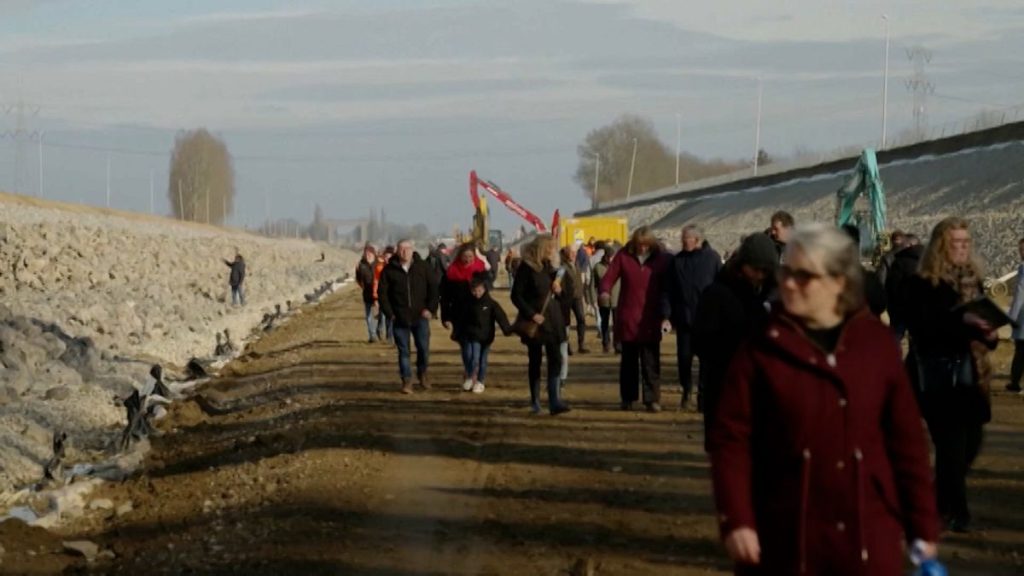A Rare Glimpse into History: Walking the Drained Juliana Canal
A Day to Remember in Limburg
This past weekend, the Dutch province of Limburg offered its residents an extraordinary experience: the chance to walk on the bottom of the dried-up Juliana Canal. For 3,600 curious locals, this was not just a unique adventure but also a rare opportunity to witness history in the making. The Juliana Canal, a 90-year-old waterway, has long been a vital part of the region’s infrastructure. However, it has become outdated for modern shipping needs, prompting a major renovation project led by Rijkswaterstaat, the executive agency of the Ministry of Infrastructure and Water Management. As part of this project, the canal was drained, revealing its hidden depths and allowing visitors to explore a landscape that is usually submerged underwater.
The open day was met with immense enthusiasm, as tickets sold out quickly. Residents gathered to marvel at the sheer scale of the construction work and to experience something that may never happen again in their lifetimes. The event was not just about engineering; it was a moment of community connection, curiosity, and wonder. For many, it was a chance to see up close how the canal, which has been a silent witness to generations of Limburgers, is being transformed to meet the demands of the future.
A New Era for the Juliana Canal
The Juliana Canal has served as a critical transportation route for nearly a century, but its current dimensions no longer accommodate the size of modern cargo ships. To address this, Rijkswaterstaat has undertaken an ambitious project to deepen and widen the canal. Once completed, it will allow larger vessels—up to 190 meters in length, 11 meters in width, and with a draught of 3.5 meters—to navigate the waterway. This upgrade is essential for ensuring that the region remains a key player in international trade and commerce.
To facilitate the renovation, engineers constructed a dam at Berg aan de Maas, enabling the gradual draining of 1.9 billion liters of water through the lock at Born. This monumental effort left a four-kilometer stretch of the canal dry, exposing its usually hidden bed. The result was an extraordinary sight: a vast, empty channel that stretched as far as the eye could see. For one day, this barren landscape became a temporary attraction, drawing in curious residents eager to explore its depths.
A Journey Through the Unexpected Landscape
Visitors who walked the bottom of the Juliana Canal were struck by the sheer scale of the project. Many remarked that the canal appeared far larger and deeper when viewed from below than when observed from a bridge or the riverbank. The experience was both humbling and awe-inspiring, offering a unique perspective on a structure that is so integral to the region’s history and economy.
Despite hopes of uncovering hidden treasures or historical artifacts, the drained canal yielded few surprises. Suzanne Maas of Rijkswaterstaat noted that the only notable finds were discarded bicycles, an old car, and a broken safe. While some visitors may have been disappointed by the lack of historical discoveries, the event was less about treasure hunting and more about connecting with the canal’s past and future.
Personal Stories and Emotional Connections
For some, the opportunity to walk the Juliana Canal was more than just a novelty—it held personal significance. One man shared a heartfelt story about his father, who had helped construct the canal decades ago. Walking through the dredged waterway brought back memories and created a sense of pride and continuity. “The fact that I can walk through it myself after so many years is very meaningful,” he said. His story highlights the emotional connection that many residents have with the canal, a connection that transcends its practical use as a transportation route.
Others, too, reflected on the canal’s role in their lives. For some, it has been a silent companion, a backdrop to daily routines and memories. For others, it has been a source of livelihood, supporting local businesses and industries. The open day offered a chance to celebrate this shared heritage while looking forward to the canal’s renewed purpose.
Looking Ahead to the Future
As the renovation progresses, excitement is building for the canal’s reopening this spring. Once the upgrades are complete, the Juliana Canal will once again flow with water, and ships will resume their journey along its length. While many visitors expressed a desire to witness the water returning, this moment is likely to be less publicized than the open day. Still, it will mark the beginning of a new chapter for the canal and the communities it serves.
For those who attended the open day, the experience will remain a cherished memory—a once-in-a-lifetime opportunity to walk where ships usually sail. It was a reminder of the ingenuity and hard work that goes into shaping our modern world and the enduring importance of infrastructure in connecting people and places. As Limburg looks to the future, the Juliana Canal stands as a testament to progress and tradition, a waterway that continues to flow through the heart of the region.
In the words of one visitor, “You have to experience this once.” For the residents of Limburg, this unique event was more than just a day out—it was a chance to step into history, to connect with the past, and to glimpse the future. And while the canal will soon return to its familiar state, the memories of this extraordinary day will linger, a reminder of the enduring bond between people, place, and progress.












